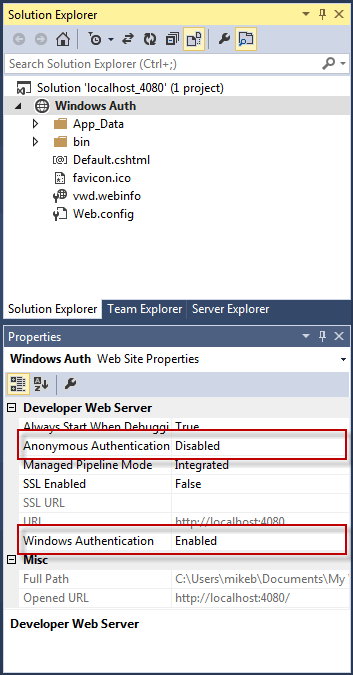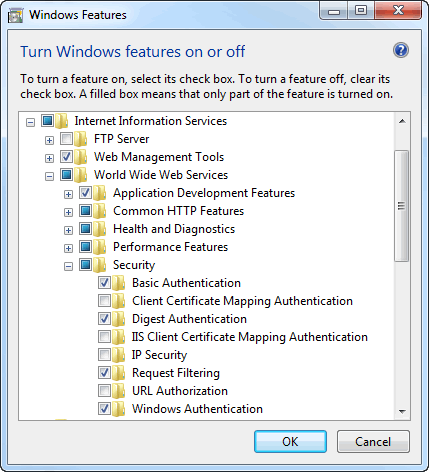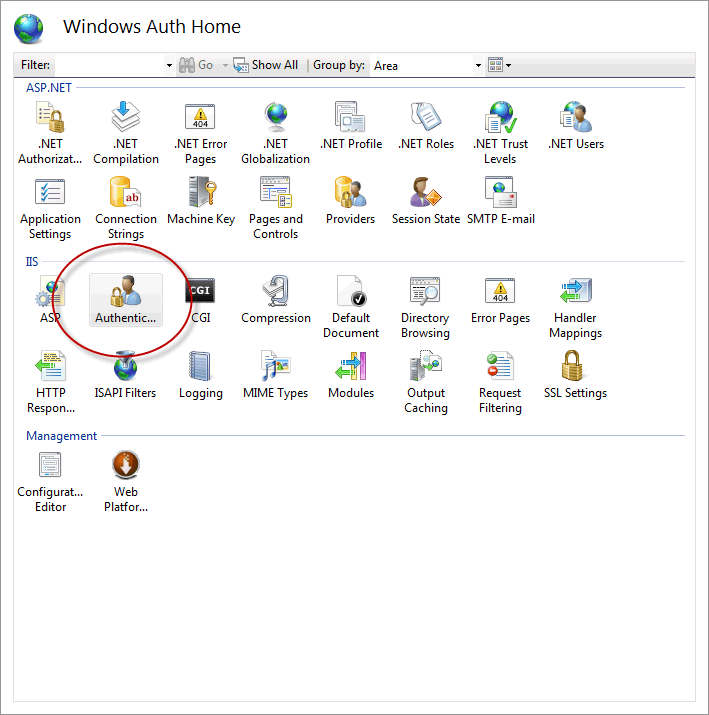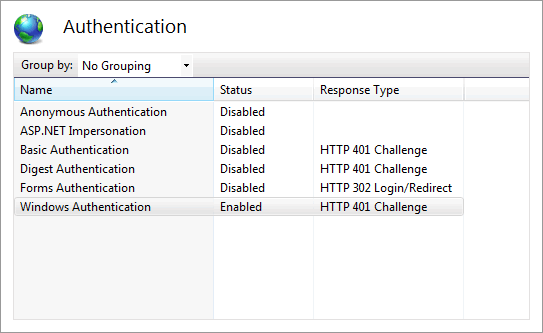Table of Contents
Introduction
When it comes to programmatically accessing Microsoft’s Active Directory a lot of people seem to have quite a difficult time tying all the pieces together to accomplish exactly what they want to. There are so many technologies available for communicating with LDAP that many programmers end up with a mix between COM+ ADSI calls and .NET class calls mixed into their code. ADSI code is so difficult to understand and follow that the creator of that code usually owns it for the entirety of it’s lifecycle since no one else wants to support it.
This article attempts to tie together the most commonly used elements involved in Active Directory Management in the simplest, most clean manner possible. I interact with Active Directory in nearly all of my applications (web & forms) and I have had to solve a lot of integration issues for many customers. When I was starting out with this technology I had a lot of growing pains so this is an attempt to help those programmers who may have a need to interact with the Directory but do not want to have to become experts in the issue. However, certain rudimentary knowledge and concepts are required in order to utilize the code. You must be familiar with such terms as: distinguishedName, ldap paths, fully qualified domain names, object attributes (single string & multi-string), and general knowledge of ldap schemas.
Background
There is a great collection of sample code available on MSDN’s website for the v1.1System.DirectoryServices assembly but there seems to be a void when it comes to the new functionality available in the v2.0 System.DirectoryServices.ActiveDirectory assembly. Since this article’s original publishing, Generics have gained widespread acceptance and I encourage anyone borrowing from this resource to replace the archaic ArrayList collections with List<T> or appropriate generic collections.
Points of Concern
In order to communicate with Active Directory one must take into account network security, business rules, and technological constraints. If you’re using Active Directory code from an ASP.NET page you must ensure that the code has the appropriate level of permission to access and interact with the directory. For development purposes or proof of concept you can enable impersonation at the ASP.NET level (in web.config) and the IIS level and if the IIS server and the directory domain controller reside on the same machine this will work. However, if these entities are not co-located on the same server (as they never are in production) you can wrap the code around an impersonation class (such as the Zeta Impersonator which will execute the Directory calls under the token of the impersonated user. It’s strongly recommended that you do not do this for security reasons unless absolutely necessary.. The authorized method for granting the ASP.NET application permission to the directory is by way of either a privileged IIS Application Pool running under the identity of a service account or by way of a COM+ entity running under the identity of a service account.
If you plan on running this code from a desktop assembly then you’re going to want to ensure that your machine is attached to a domain and can communicate with that domain. The impersonation is not necessary if the user running the code has sufficient privileges on the domain.
Running Code in Batch Processes
It is also important to note that if you plan on running this code from an ASP.NET page in batch, ASP.NET will time out on you if you try to run batch processes from it’s primary thread. There are several things to consider in this scenario but be aware that for example, if you’re creating x number of accounts through an ASP.NET application (or performing any batch operation in general) that you must plan to use queues, a back-end scheduler, or some other mechanism outside the scope of the page itself to prevent timing out during your processes. As with any ASPNET design, it’s never a good idea to use ASPNET itself for anything but the «View» part of the solution. The best architecture would queue tasks into a SQL database or something to that effect and then a back-end windows service or similar application would pick up the tasking and perform the actual Directory operations.
This is typically how I engineer Active Directory management solutions for customers.
A Note on Method Parameters
You will notice that most of the methods require the same parameters. Rather than identify each time I will outline them now:
friendlyDomainName: the non qualified domain name (contoso – NOT contoso.com)ldapDomain: the fully qualified domain such as contoso.com or dc=contoso,dc=comobjectPath: the fully qualified path to the object: CN=user, OU=USERS, DC=contoso, DC=com (same asobjectDn)objectDn: the distinguishedName of the object: CN=group, OU=GROUPS, DC=contoso, DC=comuserDn: the distinguishedName of the user: CN=user, OU=USERS, DC=contoso, DC=comgroupDn: the distinguishedName of the group: CN=group,OU=GROUPS,DC=contoso,DC=com
A Note on System.DirectoryServices.DirectoryEntry
You’ll notice in all the samples that we’re binding directly to the directoryEntry and not specifying a server or credentials. If you do not want to use an impersonation class you can send credentials directly into theDirectoryEntry constructor. The impersonation class is helpful for those times when you want to use astatic method and don’t want to go through the trouble of creating a DirectoryContext object to hold these details. Likewise you may want to target a specific domain controller.
Target Specific Domain Controllers or Credentials
Everywhere in the code that you see: LDAP: you can replace withLDAP:as well as everywhere you see a DirectoryEntry class being constructed you can send in specific credentials as well. This is especially helpful if you need to work on an Active Directory for which your machine is not a member of it’s forest or domain or you want to target a DC to make the changes to.
Hide Copy Code
public static void Rename(string server,
string userName, string password, string objectDn, string newName)
{
DirectoryEntry child = new DirectoryEntry("LDAP://" + server + "/" +
objectDn, userName, password);
child.Rename("CN=" + newName);
}
Managing local accounts with DirectoryEntry
It is important to note that you can execute some of these methods against a local machine as opposed to an Active Directory if needed by simply replacing the LDAP: string with WinNT: as demonstrated below
Hide Copy Code
DirectoryEntry localMachine = new DirectoryEntry("WinNT://" +
Environment.MachineName);
DirectoryEntry newUser = localMachine.Children.Add("localuser", "user");
newUser.Invoke("SetPassword", new object[] { "3l!teP@$$w0RDz" });
newUser.CommitChanges();
Console.WriteLine(newUser.Guid.ToString());
localMachine.Close();
newUser.Close();
Managing local groups with DirectoryEntry
A few configuration changes need to be made to the code but it’s pretty straightforward. Below you can see an example of using DirectoryEntry to enumerate the members of the local «administrator» group.
Hide Copy Code
DirectoryEntry localMachine = new DirectoryEntry
("WinNT://" + Environment.MachineName + ",Computer");
DirectoryEntry admGroup = localMachine.Children.Find
("administrators", "group");
object members = admGroup.Invoke("members", null);
foreach (object groupMember in (IEnumerable)members)
{
DirectoryEntry member = new DirectoryEntry(groupMember);
Console.WriteLine(member.Name);
}
Managing IIS with DirectoryEntry
In addition to managing local & directory services accounts, the versatile DirectoryEntry object can manage other network providers as well, such as IIS. Below is an example of how you can use DirectoryEntry to provision a new virtual directory in IIS.
Hide Copy Code
string wwwroot = "c:\\Inetpub\\wwwroot";
string virtualDirectoryName = "myNewApp";
string sitepath = "IIS://localhost/W3SVC/1/ROOT";
DirectoryEntry vRoot = new DirectoryEntry(sitepath);
DirectoryWntry vDir = vRoot.Children.Add(virtualDirectoryName,
"IIsWebVirtualDir");
vDir.CommitChanges();
vDir.Properties["Path"].Value = wwwroot + "\\" + virtualDirectoryName;
vDir.Properties["DefaultDoc"].Value = "Default.aspx";
vDir.Properties["DirBrowseFlags"].Value = 2147483648;
vDir.Commitchanges();
vRoot.CommitChanges();
Active Directory Code
The code below is broken apart logically into usage categories. Again, this is not intended to be a complete library, just the code that I use on a daily basis.
Active Directory Management
Hide Copy Code
using System.DirectoryServices;
using System.DirectoryServices.ActiveDirectory;
Translate the Friendly Domain Name to Fully Qualified Domain
Hide Copy Code
public static string FriendlyDomainToLdapDomain(string friendlyDomainName)
{
string ldapPath = null;
try
{
DirectoryContext objContext = new DirectoryContext(
DirectoryContextType.Domain, friendlyDomainName);
Domain objDomain = Domain.GetDomain(objContext);
ldapPath = objDomain.Name;
}
catch (DirectoryServicesCOMException e)
{
ldapPath = e.Message.ToString();
}
return ldapPath;
}
Enumerate Domains in the Current Forest
Hide Copy Code
public static ArrayList EnumerateDomains()
{
ArrayList alDomains = new ArrayList();
Forest currentForest = Forest.GetCurrentForest();
DomainCollection myDomains = currentForest.Domains;
foreach (Domain objDomain in myDomains)
{
alDomains.Add(objDomain.Name);
}
return alDomains;
}
Enumerate Global Catalogs in the Current Forest
Hide Copy Code
public static ArrayList EnumerateDomains()
{
ArrayList alGCs = new ArrayList();
Forest currentForest = Forest.GetCurrentForest();
foreach (GlobalCatalog gc in currentForest.GlobalCatalogs)
{
alGCs.Add(gc.Name);
}
return alGCs;
}
Enumerate Domain Controllers in a Domain
Hide Copy Code
public static ArrayList EnumerateDomainControllers()
{
ArrayList alDcs = new ArrayList();
Domain domain = Domain.GetCurrentDomain();
foreach (DomainController dc in domain.DomainControllers)
{
alDcs.Add(dc.Name);
}
return alDcs;
}
Create a Trust Relationship
Hide Copy Code
public void CreateTrust(string sourceForestName, string targetForestName)
{
Forest sourceForest = Forest.GetForest(new DirectoryContext(
DirectoryContextType.Forest, sourceForestName));
Forest targetForest = Forest.GetForest(new DirectoryContext(
DirectoryContextType.Forest, targetForestName));
sourceForest.CreateTrustRelationship(targetForest,
TrustDirection.Outbound);
}
Delete a Trust Relationship
Hide Copy Code
public void DeleteTrust(string sourceForestName, string targetForestName)
{
Forest sourceForest = Forest.GetForest(new DirectoryContext(
DirectoryContextType.Forest, sourceForestName));
Forest targetForest = Forest.GetForest(new DirectoryContext(
DirectoryContextType.Forest, targetForestName));
sourceForest.DeleteTrustRelationship(targetForest);
}
Enumerate Objects in an OU
The parameter OuDn is the Organizational Unit distinguishedName such asOU=Users,dc=myDomain,dc=com
Hide Copy Code
public ArrayList EnumerateOU(string OuDn)
{
ArrayList alObjects = new ArrayList();
try
{
DirectoryEntry directoryObject = new DirectoryEntry("LDAP://" + OuDn);
foreach (DirectoryEntry child in directoryObject.Children)
{
string childPath = child.Path.ToString();
alObjects.Add(childPath.Remove(0,7));
child.Close();
child.Dispose();
}
directoryObject.Close();
directoryObject.Dispose();
}
catch (DirectoryServicesCOMException e)
{
Console.WriteLine("An Error Occurred: " + e.Message.ToString());
}
return alObjects;
}
Enumerate Directory Entry Settings
One of the nice things about the 2.0 classes is the ability to get and set a configuration object for yourdirectoryEntry objects.
Hide Copy Code
static void DirectoryEntryConfigurationSettings(string domainADsPath)
{
DirectoryEntry entry = new DirectoryEntry(domainADsPath);
DirectoryEntryConfiguration entryConfiguration = entry.Options;
Console.WriteLine("Server: " + entryConfiguration.GetCurrentServerName());
Console.WriteLine("Page Size: " + entryConfiguration.PageSize.ToString());
Console.WriteLine("Password Encoding: " +
entryConfiguration.PasswordEncoding.ToString());
Console.WriteLine("Password Port: " +
entryConfiguration.PasswordPort.ToString());
Console.WriteLine("Referral: " + entryConfiguration.Referral.ToString());
Console.WriteLine("Security Masks: " +
entryConfiguration.SecurityMasks.ToString());
Console.WriteLine("Is Mutually Authenticated: " +
entryConfiguration.IsMutuallyAuthenticated().ToString());
Console.WriteLine();
Console.ReadLine();
}
Active Directory Objects
Hide Copy Code
using System.DirectoryServices;
Check for the Existence of an Object
This method does not need you to know the distinguishedName, you can concat strings or even guess a location and it will still run (and return false if not found).
Hide Copy Code
public static bool Exists(string objectPath)
{
bool found = false;
if (DirectoryEntry.Exists("LDAP://" + objectPath))
{
found = true;
}
return found;
}
Move an Object from one Location to Another
It should be noted that the string newLocation should NOT include the CN= value of the object. The method will pull that from the objectLocation string for you. So object CN=group,OU=GROUPS,DC=contoso,DC=comis sent in as the objectLocation but the newLocation is something like:OU=NewOUParent,DC=contoso,DC=com. The method will take care of the CN=group.
Hide Copy Code
public void Move(string objectLocation, string newLocation)
{
DirectoryEntry eLocation = new DirectoryEntry("LDAP://" + objectLocation);
DirectoryEntry nLocation = new DirectoryEntry("LDAP://" + newLocation);
string newName = eLocation.Name;
eLocation.MoveTo(nLocation, newName);
nLocation.Close();
eLocation.Close();
}
Enumerate Multi-String Attribute Values of an Object
This method includes a recursive flag in case you want to recursively dig up properties of properties such as enumerating all the member values of a group and then getting each member group’s groups all the way up the tree.
Hide Copy Code
public ArrayList AttributeValuesMultiString(string attributeName,
string objectDn, ArrayList valuesCollection, bool recursive)
{
DirectoryEntry ent = new DirectoryEntry(objectDn);
PropertyValueCollection ValueCollection = ent.Properties[attributeName];
IEnumerator en = ValueCollection.GetEnumerator();
while (en.MoveNext())
{
if (en.Current != null)
{
if (!valuesCollection.Contains(en.Current.ToString()))
{
valuesCollection.Add(en.Current.ToString());
if (recursive)
{
AttributeValuesMultiString(attributeName, "LDAP://" +
en.Current.ToString(), valuesCollection, true);
}
}
}
}
ent.Close();
ent.Dispose();
return valuesCollection;
}
Enumerate Single String Attribute Values of an Object
Hide Copy Code
public string AttributeValuesSingleString
(string attributeName, string objectDn)
{
string strValue;
DirectoryEntry ent = new DirectoryEntry(objectDn);
strValue = ent.Properties[attributeName].Value.ToString();
ent.Close();
ent.Dispose();
return strValue;
}
Enumerate an Object’s Properties: The Ones with Values
Hide Copy Code
public static ArrayList GetUsedAttributes(string objectDn)
{
DirectoryEntry objRootDSE = new DirectoryEntry("LDAP://" + objectDn);
ArrayList props = new ArrayList();
foreach (string strAttrName in objRootDSE.Properties.PropertyNames)
{
props.Add(strAttrName);
}
return props;
}
Get an Object DistinguishedName: ADO.NET search (ADVANCED)
This method is the glue that ties all the methods together since most all the methods require the consumer to provide a distinguishedName. Wherever you put this code, you must ensure that you add these enumerations as well. This allows the consumers to specify the type of object to search for and whether they want thedistinguishedName returned or the objectGUID.
Hide Copy Code
public enum objectClass
{
user, group, computer
}
public enum returnType
{
distinguishedName, ObjectGUID
}
A call to this class might look like:
myObjectReference.GetObjectDistinguishedName(objectClass.user, returnType.ObjectGUID,"john.q.public", "contoso.com")
Hide Shrink 
Copy Code
public string GetObjectDistinguishedName(objectClass objectCls,
returnType returnValue, string objectName, string LdapDomain)
{
string distinguishedName = string.Empty;
string connectionPrefix = "LDAP://" + LdapDomain;
DirectoryEntry entry = new DirectoryEntry(connectionPrefix);
DirectorySearcher mySearcher = new DirectorySearcher(entry);
switch (objectCls)
{
case objectClass.user:
mySearcher.Filter = "(&(objectClass=user)
(|(cn=" + objectName + ")(sAMAccountName=" + objectName + ")))";
break;
case objectClass.group:
mySearcher.Filter = "(&(objectClass=group)
(|(cn=" + objectName + ")(dn=" + objectName + ")))";
break;
case objectClass.computer:
mySearcher.Filter = "(&(objectClass=computer)
(|(cn=" + objectName + ")(dn=" + objectName + ")))";
break;
}
SearchResult result = mySearcher.FindOne();
if (result == null)
{
throw new NullReferenceException
("unable to locate the distinguishedName for the object " +
objectName + " in the " + LdapDomain + " domain");
}
DirectoryEntry directoryObject = result.GetDirectoryEntry();
if (returnValue.Equals(returnType.distinguishedName))
{
distinguishedName = "LDAP://" + directoryObject.Properties
["distinguishedName"].Value;
}
if (returnValue.Equals(returnType.ObjectGUID))
{
distinguishedName = directoryObject.Guid.ToString();
}
entry.Close();
entry.Dispose();
mySearcher.Dispose();
return distinguishedName;
}
Convert distinguishedName to ObjectGUID
Hide Copy Code
public string ConvertDNtoGUID(string objectDN)
{
DirectoryEntry directoryObject = new DirectoryEntry(objectDN);
return directoryObject.Guid.ToString();
}
Convert an ObjectGUID to OctectString: The Native ObjectGUID
Hide Copy Code
public static string ConvertGuidToOctectString(string objectGuid)
{
System.Guid guid = new Guid(objectGuid);
byte[] byteGuid = guid.ToByteArray();
string queryGuid = "";
foreach (byte b in byteGuid)
{
queryGuid += @"\" + b.ToString("x2");
}
return queryGuid;
}
Search by ObjectGUID or convert ObjectGUID to distinguishedName
Hide Copy Code
public static string ConvertGuidToDn(string GUID)
{
DirectoryEntry ent = new DirectoryEntry();
String ADGuid = ent.NativeGuid;
DirectoryEntry x = new DirectoryEntry("LDAP://{GUID=" + ADGuid + ">");
return x.Path.Remove(0,7);
}
Publish Network Shares in Active Directory
Hide Copy Code
private void init()
{
CreateShareEntry("OU=HOME,dc=baileysoft,dc=com",
"Music", @"\\192.168.2.1\Music", "mp3 Server Share");
Console.ReadLine();
}
public void CreateShareEntry(string ldapPath,
string shareName, string shareUncPath, string shareDescription)
{
string oGUID = string.Empty;
string connectionPrefix = "LDAP://" + ldapPath;
DirectoryEntry directoryObject = new DirectoryEntry(connectionPrefix);
DirectoryEntry networkShare = directoryObject.Children.Add("CN=" +
shareName, "volume");
networkShare.Properties["uNCName"].Value = shareUncPath;
networkShare.Properties["Description"].Value = shareDescription;
networkShare.CommitChanges();
directoryObject.Close();
networkShare.Close();
}
Create a New Security Group
Note: by default if no GroupType property is set, the group is created as a domain security group.
Hide Copy Code
public void Create(string ouPath, string name)
{
if (!DirectoryEntry.Exists("LDAP://CN=" + name + "," + ouPath))
{
try
{
DirectoryEntry entry = new DirectoryEntry("LDAP://" + ouPath);
DirectoryEntry group = entry.Children.Add("CN=" + name, "group");
group.Properties["sAmAccountName"].Value = name;
group.CommitChanges();
}
catch (Exception e)
{
Console.WriteLine(e.Message.ToString());
}
}
else { Console.WriteLine(path + " already exists"); }
}
Delete a group
Hide Copy Code
public void Delete(string ouPath, string groupPath)
{
if (DirectoryEntry.Exists("LDAP://" + groupPath))
{
try
{
DirectoryEntry entry = new DirectoryEntry("LDAP://" + ouPath);
DirectoryEntry group = new DirectoryEntry("LDAP://" + groupPath);
entry.Children.Remove(group);
group.CommitChanges();
}
catch (Exception e)
{
Console.WriteLine(e.Message.ToString());
}
}
else
{
Console.WriteLine(path + " doesn't exist");
}
}
Active Directory Users Tasks
Hide Copy Code
using System.DirectoryServices;
Authenticate a User Against the Directory
Per John Storer, thanks for sharing.
Hide Copy Code
private bool Authenticate(string userName,
string password, string domain)
{
bool authentic = false;
try
{
DirectoryEntry entry = new DirectoryEntry("LDAP://" + domain,
userName, password);
object nativeObject = entry.NativeObject;
authentic = true;
}
catch (DirectoryServicesCOMException) { }
return authentic;
}
Add User to Group
Hide Copy Code
public void AddToGroup(string userDn, string groupDn)
{
try
{
DirectoryEntry dirEntry = new DirectoryEntry("LDAP://" + groupDn);
dirEntry.Properties["member"].Add(userDn);
dirEntry.CommitChanges();
dirEntry.Close();
}
catch (System.DirectoryServices.DirectoryServicesCOMException E)
{
}
}
Remove User from Group
Hide Copy Code
public void RemoveUserFromGroup(string userDn, string groupDn)
{
try
{
DirectoryEntry dirEntry = new DirectoryEntry("LDAP://" + groupDn);
dirEntry.Properties["member"].Remove(userDn);
dirEntry.CommitChanges();
dirEntry.Close();
}
catch (System.DirectoryServices.DirectoryServicesCOMException E)
{
}
}
Get User Group Memberships of the Logged in User from ASP.NET
Hide Copy Code
public ArrayList Groups()
{
ArrayList groups = new ArrayList();
foreach (System.Security.Principal.IdentityReference group in
System.Web.HttpContext.Current.Request.LogonUserIdentity.Groups)
{
groups.Add(group.Translate(typeof
(System.Security.Principal.NTAccount)).ToString());
}
return groups;
}
Get User Group Memberships
This method requires that you have the AttributeValuesMultiString method earlier in the article included in your class.
Hide Copy Code
public ArrayList Groups(string userDn, bool recursive)
{
ArrayList groupMemberships = new ArrayList();
return AttributeValuesMultiString("memberOf", userDn,
groupMemberships, recursive);
}
Create User Account
Hide Copy Code
public string CreateUserAccount(string ldapPath, string userName,
string userPassword)
{
try
{
string oGUID = string.Empty;
string connectionPrefix = "LDAP://" + ldapPath;
DirectoryEntry dirEntry = new DirectoryEntry(connectionPrefix);
DirectoryEntry newUser = dirEntry.Children.Add
("CN=" + userName, "user");
newUser.Properties["samAccountName"].Value = userName;
newUser.CommitChanges();
oGUID = newUser.Guid.ToString();
newUser.Invoke("SetPassword", new object[] { userPassword });
newUser.CommitChanges();
dirEntry.Close();
newUser.Close();
}
catch (System.DirectoryServices.DirectoryServicesCOMException E)
{
}
return oGUID;
}
Dealing with User Passwords
There are some specifics to understand when dealing with user passwords and boundaries around passwords such as forcing a user to change their password on the next logon, denying the user the right to change their own passwords, setting passwords to never expire, to when to expire, and these tasks can be accomplished usingUserAccountControl flags that are demonstrated in the proceeding sections. Please refer to this great MSDN article: Managing User Passwords for examples and documentation regarding these features. (thanks to Daniel Ocean for identifying this resource)
Hide Copy Code
int val = (int)newUser.Properties["userAccountControl"].Value;
newUser.Properties["userAccountControl"].Value = val | 0x80000;
All UserAccountControl flags
Hide Copy Code
CONST HEX
-------------------------------
SCRIPT 0x0001
ACCOUNTDISABLE 0x0002
HOMEDIR_REQUIRED 0x0008
LOCKOUT 0x0010
PASSWD_NOTREQD 0x0020
PASSWD_CANT_CHANGE 0x0040
ENCRYPTED_TEXT_PWD_ALLOWED 0x0080
TEMP_DUPLICATE_ACCOUNT 0x0100
NORMAL_ACCOUNT 0x0200
INTERDOMAIN_TRUST_ACCOUNT 0x0800
WORKSTATION_TRUST_ACCOUNT 0x1000
SERVER_TRUST_ACCOUNT 0x2000
DONT_EXPIRE_PASSWORD 0x10000
MNS_LOGON_ACCOUNT 0x20000
SMARTCARD_REQUIRED 0x40000
TRUSTED_FOR_DELEGATION 0x80000
NOT_DELEGATED 0x100000
USE_DES_KEY_ONLY 0x200000
DONT_REQ_PREAUTH 0x400000
PASSWORD_EXPIRED 0x800000
TRUSTED_TO_AUTH_FOR_DELEGATION 0x1000000
Enable a User Account
Hide Copy Code
public void Enable(string userDn)
{
try
{
DirectoryEntry user = new DirectoryEntry(userDn);
int val = (int)user.Properties["userAccountControl"].Value;
user.Properties["userAccountControl"].Value = val & ~0x2;
user.CommitChanges();
user.Close();
}
catch (System.DirectoryServices.DirectoryServicesCOMException E)
{
}
}
Disable a User Account
Hide Copy Code
public void Disable(string userDn)
{
try
{
DirectoryEntry user = new DirectoryEntry(userDn);
int val = (int)user.Properties["userAccountControl"].Value;
user.Properties["userAccountControl"].Value = val | 0x2;
user.CommitChanges();
user.Close();
}
catch (System.DirectoryServices.DirectoryServicesCOMException E)
{
}
}
Unlock a User Account
Hide Copy Code
public void Unlock(string userDn)
{
try
{
DirectoryEntry uEntry = new DirectoryEntry(userDn);
uEntry.Properties["LockOutTime"].Value = 0;
uEntry.CommitChanges();
uEntry.Close();
}
catch (System.DirectoryServices.DirectoryServicesCOMException E)
{
}
}
Alternate Lock/Unlock Account
It’s hard to find code to lock an account. Here is my code to lock or unlock an account. dEntry is class variable already set to a user account. Shared by dextrous1.
Hide Copy Code
public bool IsLocked
{
get { return Convert.ToBoolean(dEntry.InvokeGet("IsAccountLocked")); }
set { dEntry.InvokeSet("IsAccountLocked", value); }
}
Reset a User Password
Hide Copy Code
public void ResetPassword(string userDn, string password)
{
DirectoryEntry uEntry = new DirectoryEntry(userDn);
uEntry.Invoke("SetPassword", new object[] { password });
uEntry.Properties["LockOutTime"].Value = 0;
uEntry.Close();
}
Rename an Object
Hide Copy Code
public static void Rename(string objectDn, string newName)
{
DirectoryEntry child = new DirectoryEntry("LDAP://" + objectDn);
child.Rename("CN=" + newName);
}
Conclusion
I would have liked to include a sample project but my professional code is so tightly integrated with customer proprietary code that it was not feasible at this time.
UPDATE
If you would like to see an extremely simple implementation of some of this code check out theDirectoryServicesBrowserDialog I posted some time ago. This should demonstrate to those of you who are having trouble adding the proper references or having other difficulties.
I hope this helps out all those programmers that were like me and had to get up to speed really quickly and lost countless hours studying the System.DirectoryServices assembly trying to dig up answers on how to do AD tasks.
If you have some additional segments of code that are small but efficient that you’d like to include send them to me and I’ll add them to this document.
History
- Originally submitted – 22 March 2007
- Added
GetUsedAttributes() method – 24 March 2007
- Added
EnumerateOU() method – 25 March 2007
- Added
CreateShareEntry() – 27 March 2007
- Added
CommitChanged() call in UnlockUserAccount()
- Cleaned up article, added a few new methods – 03 Apr 2007
- Added note on
DirectoryEntry – 04 Apr 2007
- Added note on working with local accounts – 12 Apr 2007
- Added code for creating/deleting groups – 20 Apr 2007
- Added John Storer’s code for authenticating users against the directory
- Added
UserAccountControl flags section – 06 Jun 2007
- Added Managing IIS with
DirectoryEntry() section – 12 Jun 2007
- Created table of contents – 09 Jul 2007
- Added Dealing with User Passwords Section – 21 May 2008
- Added Alternate Lock/Unlock Account by dextrous1 – 21 May 2008




 Copy Code
Copy Code


